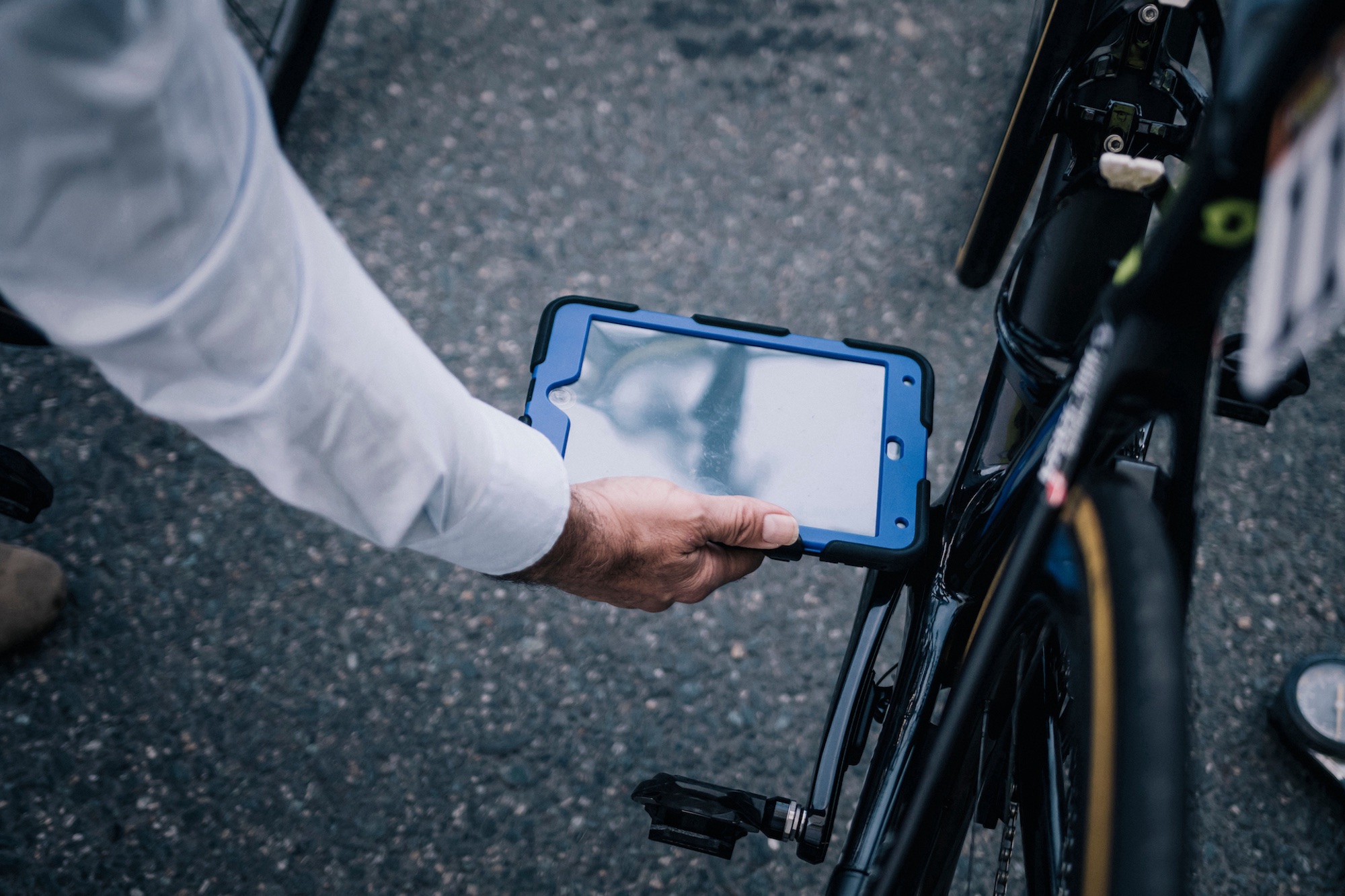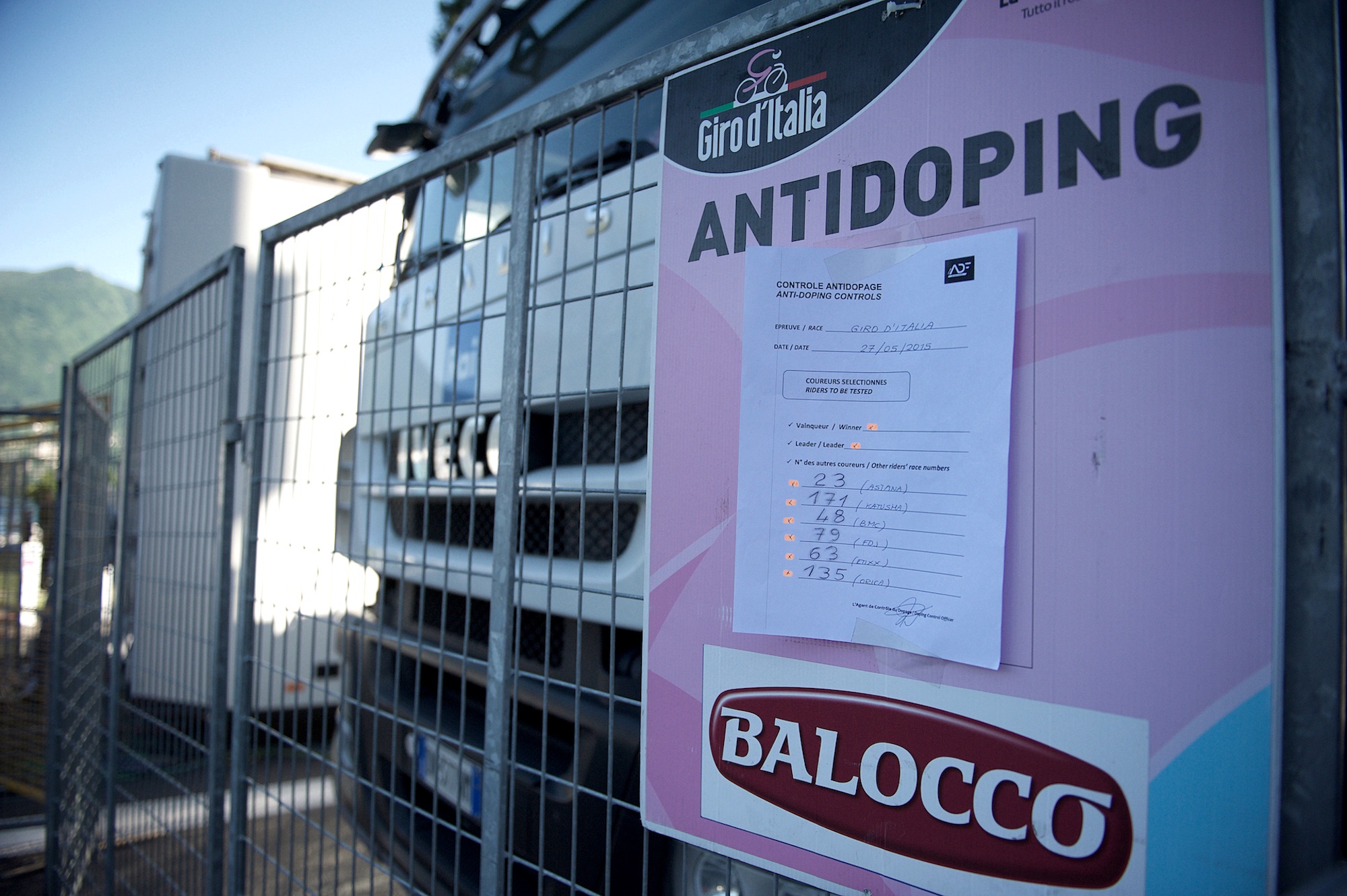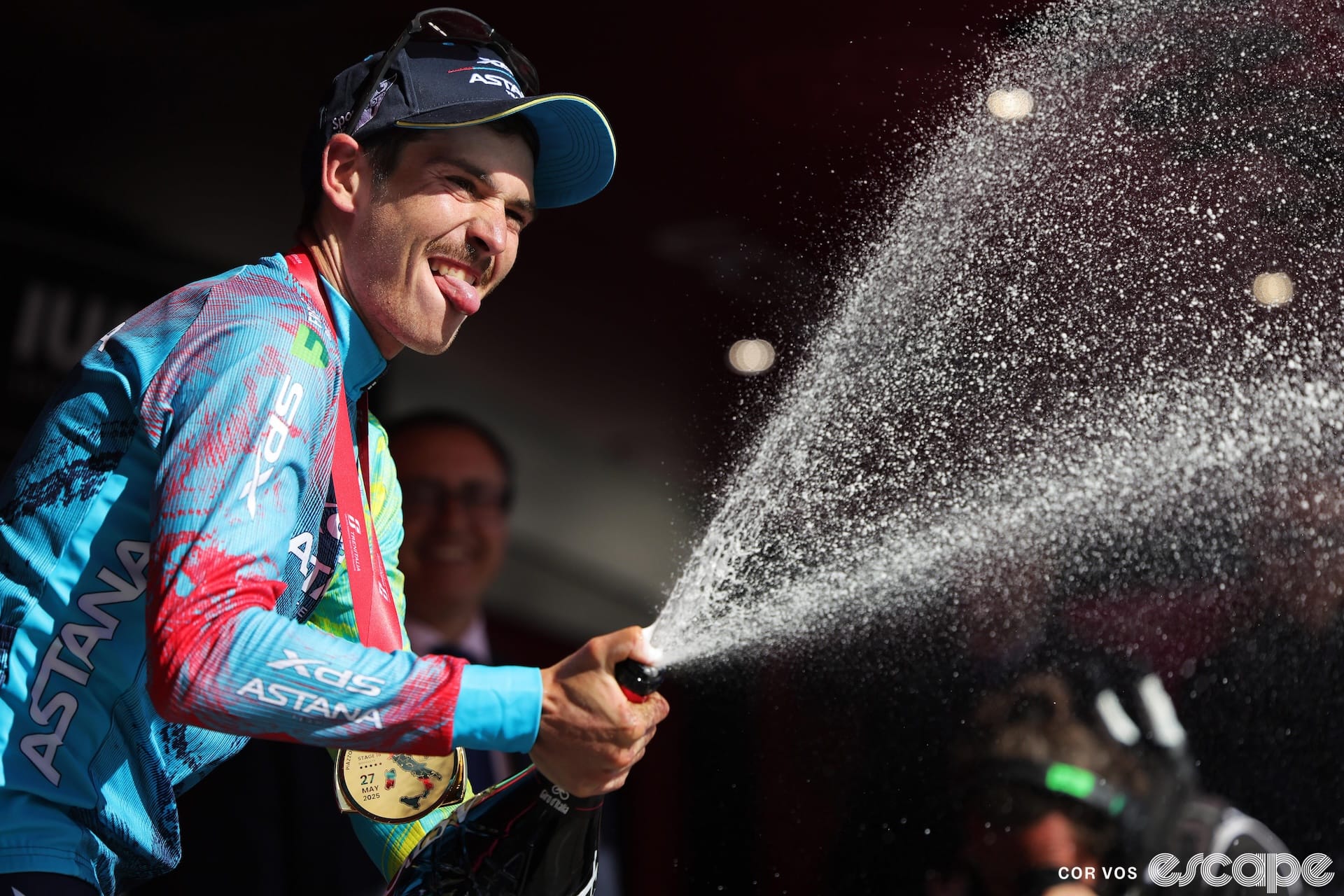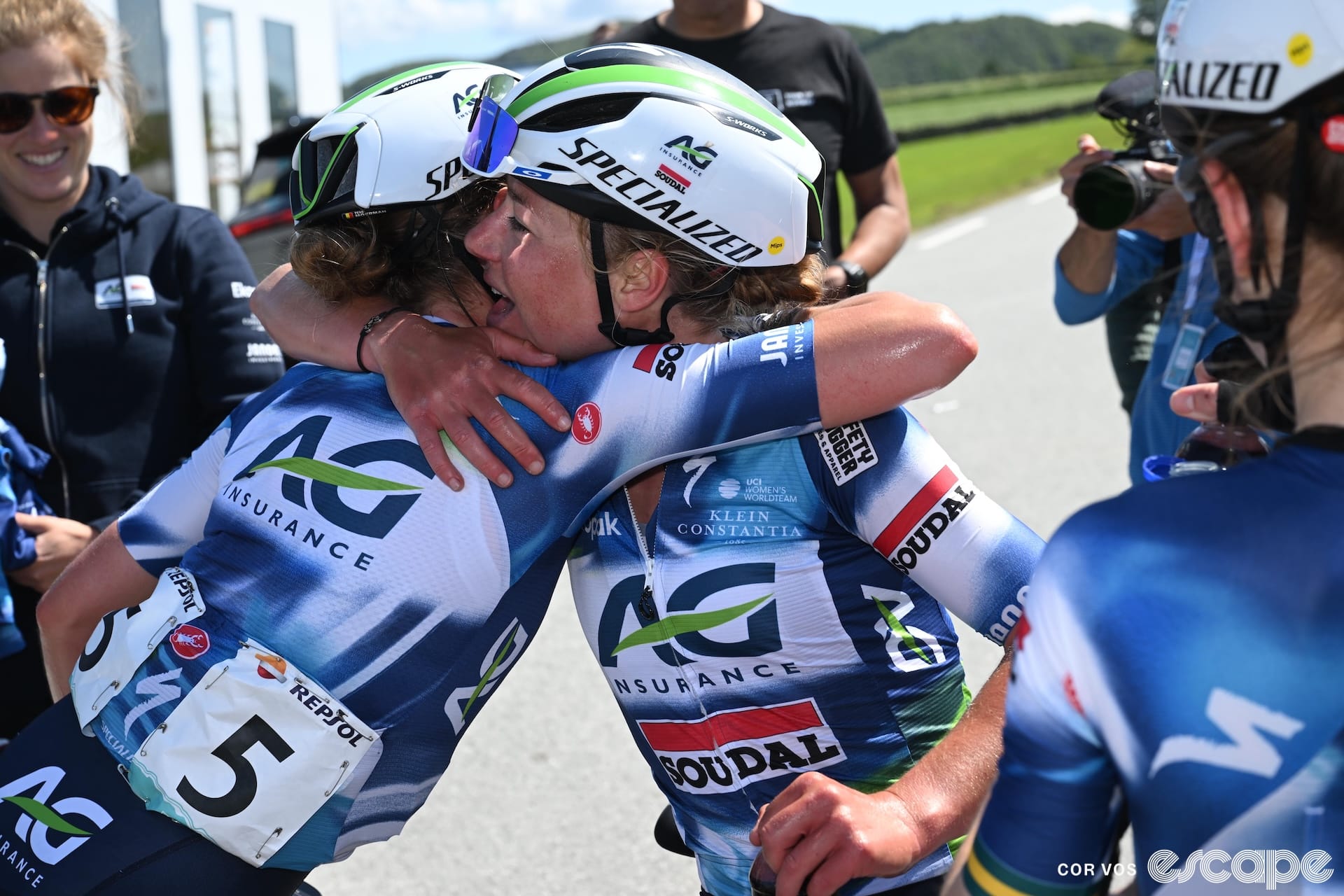“I have no words to answer this question,” Wout van Aert said at the winner’s press conference of the 2022 Tour de France, when what should have been a triumphant moment was instantly soured. “It’s such a shit question. It comes back every time after someone’s won.”
The Belgian was responding to the now annual, customary query to all Tour victors about whether his and his team’s dominant performance at the race could be trusted. The moment was a perfect distillation of the current impasse felt by bike racing, a state of affairs that also seems to reflect the situation in our bigger, real world.
Van Aert was visibly annoyed and frustrated at the lack of trust being shown to him, explaining that we were seeing a new generation of riders. The issue for these claims is that the then 27-year-old can’t point to a true break with the past because it doesn’t exist. Instead, distrust lingers and any meaningful discourse lies mostly in tatters after years of questions, terrible answers and vitriolic public reaction, causing both sides to become further entrenched in their point of view.
“If we’re now living in a ‘post-truth’ society,” wrote the psychologist brothers Daniel and Jason Freeman in the Guardian, “with traditionally trusted sources of information routinely undermined and informal communication possible like never before via the Internet, one of the dubious fruits of this febrile climate may be a growth in the power and reach of conspiracy theories.”
The sport’s historic willingness to engage openly with the uglier trappings of elite performance has seen fake heroes felled and subsequent superstars shrouded in distrust. The argument goes that if only a few of the cheaters fess up or are caught, how do you know who to believe? None of this is new; recall the second Tour, in 1904, when riders were suspected of being towed by cars, and the top four finishers were later disqualified for having taken a train to the finish. While cheating seems incompatible with any notion we have of sporting fairness or what bike racing should be, the mystique of the sport is built upon not only superhuman effort and toil, but also the struggles of honesty versus deception, of humanity in its full spectrum.
The problem is not whether dopers can come back after suspensions, but that there are undoubtedly individuals within the peloton and team’s backroom staff who have cheated and never been caught, or never really been held accountable for the things that happened on their watch. Van Aert, fairly or not, bears the burden of that history. Cycling is in its post-truth era, and has been for some time.
Because the internet
The idea of surreptitiously hopping on a train to get to the finish first is, of course, as hopelessly quaint today as the idea of starting a bike race to sell newspapers. Just as with all news and popular global conspiracies, the internet has changed how bike racing is enjoyed and discussed by its audience.
The EPO era’s reckoning coincided with the proliferation of, first, forums and message boards, and then social media. Cycling remains a niche sport in many parts of the world and the internet brought its sparsely populated followers together under one digital roof. To celebrate, to inquire, to grieve, to gossip. It supercharged dialogue at a time when extracting candour from within the sport became increasingly challenging. These online spaces – first comments sections, then forums, and finally places like Twitter – became hotbeds of conjecture, of conspiracy theory to fill the vacuum of information.
But in a marked difference to theories about the moon landing being faked, USADA’s bombshell Reasoned Decision and Lance Armstrong’s subsequent admission that he had doped was like if NASA came out and said Neil Armstrong had been doing little more than bouncing around on a film set in a space suit. On the U.S. Postal Service team, conspiracy theory was found to be an actual conspiracy reaching to the very top of the sport. And so, with every new inkling of nefariousness on much smaller scales, the question loiters that if the “greatest fraud” was nearly pulled off, then who’s to say there is no weight to any of the lesser conspiracies?
In the aftermath of Lance telling the truth for possibly the first time in his professional life, online forums and Twitter were there for cycling fans to exercise the catharsis needed following the fraud in a space where they found they weren’t alone in their fears and suspicions. But the difference with social media is that people were no longer tucked away in dark corners of the internet that had to be sought out. Instead, anyone was only an @ away from posing their scepticism directly to the rider they suspected - a fact that has led to liberal use of the block button. The blocked then take their blocking as a badge of honour that they are right, while the blockers tire of what they see as internet randos’ baseless accusations and abuse. The psychology of a conspiracy theory is that every piece of evidence is taken as confirmation.
In 2010, a couple of years before the Armstrong admission, the major conspiracy theory was accusations of Fabian Cancellara’s alleged motor doping. Even Tom Boonen, his rival that spring, eventually added his voice to the lingering doubt. Video footage of that Tour of Flanders – the bike change! the sudden acceleration! the mysterious hand movements! – was broken down and annotated to within an inch of its life by those who theorised the Swiss rider had cheated. The total audience of this theory was in the millions, and the discussion that followed clocked up an even more impossible number of hours. This conversation, both its subject and the scale and speed at which it happened, could not exist in the pre-internet era. To gauge the legacy more than a decade on, I asked someone I know who has likely forgotten more about bike racing than I’ll ever know: “Gun to your head, is the Cancellara motor doping theory fact or fiction?” Their reply: “You’d probably shoot me before I can answer one way or the other.”
“To clarify,” the conversation continues a month later when I double check whether I can use their quote in this piece. “The reason I can’t answer is what makes it so fascinating. On the one hand, [motor doping at some point] has surely happened. No doubt. But on the other … it’s the two biggest Classics of the year and one of the biggest names ... Surely not …”
An endless feedback loop
The calls for a truth and reconciliation process to be set up post-Armstrong were co-opted and neutered into the Cycling Independent Reform Commission’s forgettable report, so what we have now is an enduring, courageless hangover, one that has persisted through the Team Sky era (whose utilisation of grey areas has only ever added fuel to the fire in this post-truth landscape) and has touched many other teams in the years that followed.
The internet has given a voice, and therefore power, back to the fans. If the audience sees something they believe is too good to be true, they can air that opinion, for anyone and everyone to see. A few years ago, in an article that never made it to publication, I spoke to a number of the more vocal anti-doping accounts on Twitter, in an attempt to gain an insight into people who dedicate a fair number of hours to the online anti-doping cause.

‘Anti-doping cause’ is probably too narrow a definition; it’s more of a guerrilla faction of the cycling audience who are vociferous in their adjudication of athletes they decide are not playing by the rules. These people range in both their tenacity and the wildness of their accusations. The more extreme definitely taint the more moderate, making it easy for all who question to be cast as purchasers of tin foil hats – just like with real world conspiracy theories and theorists. I would not be surprised if certain members of anti-doping Twitter, if they happen to read this article, will take umbrage with anything less than full support for their cause. It is an online stance and persona that is all-consuming and unbending, one shared with general conspiracy theorists of all stripes.
“Twitter, for all its faults, at least gives you a chance to get your point of view across and engage with people,” one person told me. It feels fairer to maintain their anonymity (in terms of their username) given the amount of time that’s passed since their response.
Only a few use their real names online for fear of reprisals, they tell me, which informs us of the existing power imbalance in this debate and also how these online communities operate through strength in numbers. Yet that same anonymity allows them to be dismissed as nothing more than trolls and people who don’t know what they’re talking about, and more poison enters circulation. One person tells me their background is actually in elite sport, but the potential damage of making public denouncements isn’t worth the trouble. On the other hand, a tweet from someone with a handful of followers that manages to capture an emotion shared widely can go viral. Twitter's great leveling power is that anyone can speak with a loud voice.
“It allows me to voice my opinion,” the person continued. “Whether that makes a difference, I don’t know. I’d like to think at the very least some people will start to question things too and not take everything at face value. I highly doubt I can effect the change I’d like to see as elite sport is corrupt from top to bottom and those in power will cling to it for dear life but if enough people start to ask questions then maybe, just maybe, change will happen.”
“As a Twitter 'troll' what really changed is access to fellow sceptics and cynics,” another added. “[Before] there was no way I could discuss with them easily. Now we can discuss on a regular basis.”
It’s not only the availability of discussion online, but also the amount of data available to pore over, from videos that show unnatural accelerations that supercharge discussion to formulas that calculate estimated power output with a reasonable level of accuracy. From this, people can draw conclusions and form opinions. Frictionlessly, it elevates the slightly odd to proof of wrongdoing without much pushback.
As is often the case, it’s the members of the peloton who get the rough end of the stick. Distrusted by sections of cycling’s fan base and media, as well as a wider public that often encounters pro cycling only when scandal breaks, they are forced to bear the brunt of the sport’s chaotic economic model, all while having to structure their life around whereabouts and drug testing. It is a raw deal for clean athletes who have to find a way to make peace with this brutal system.
Riders may hold doubts over their competitors and rival teams, but have little to gain from airing them publicly. They may discuss doubts with friends and family, maybe even with peers they trust. I’ve even had one rider tell me off the record during a phone interview about misgivings about another athlete. But the amount of competition for places in professional squads incentivises not causing trouble for your employers, and the financial precariousness of the sport’s economic structure means all behaviour and messaging usually trends towards a brand-safe banality aimed at making sure funding continues.
Those are powerful incentives, because in a post-truth world, no one is above suspicion. Even Groupama-FDJ, who are MPCC members and have star riders such as Thibaut Pinot openly talking to the press about his concerns over how clean the peloton currently is, have been subjected to whisperings following some strong performances at the start of the 2023 season. Their precarity usually breeds silence. Everyone suffers in the vacuum of absolute truth. A feedback loop is created: the silence of the riders and teams breeds further suspicion and produces harder questions from fans and the media, leading to just more silence and mutual distrust.
Speaking of precarity, consider the media, with a need to balance journalistic instinct that suggests all may not be what it seems with evidence – on the record – pertaining to any suspicion. That video may look dodgy, but can you prove it? There are real liability stakes; journalists work for media companies that can be sued, quite different than posting from behind a faceless Twitter account created with a burner email address. That's not to mention the risk that highlighting yourself as a reporter who will ask these questions might pose to the level of access you are permitted to the teams and riders. How is one to navigate such a world?
“‘Trust, but verify,’” writes my colleague Kate Wagner of the old axiom. “Perhaps a better one for cycling would be ‘Distrust, but verify.’ As a fan, this is incredibly hard to do simply because we all want to believe what we are seeing is real. We want, so badly, to believe that all is right with the world and that our sport can be enjoyed without having to constantly look over our shoulders at the doping boogeyman. Most of all, we want our love for these athletes to be justified, for our intense emotional investment to not be misplaced. After all, it is impossible to love without trust. It is far easier to be cynical and bitter and be correct than it is to grieve for something you deeply believed in.” Yet it requires a stern stomach and a rugged mentality to willingly open yourself up for grief time and again. But what’s the alternative? To live a smaller life steeped in unrelenting distrust and cynicism? A complete loss of hope leads to embitterment. It’s safer to be a sceptic, but better to be a hopeful one.
Not all conspiracy theories are created equal
In researching this article, I asked cycling fans for the wildest conspiracy theories they’d heard and the list that came back veered from the batshit crazy to the humorously untrue.
Let’s start with the fun one, the one that those involved in certainly won’t mind being aired and having even an ounce of new life breathed into it, which is that Mitchelton-Scott swapped over the Yates twins mid-way through the 2018 Vuelta a España en route to ‘Simon’ Yates winning the red jersey. Just imagine that for a second, the possibility of it being pulled off. The ultimate marginal gain of winning a Grand Tour: being a twin. Someone else then chimed in with a further extension of this hypothesis that there is in fact a secret third Yates sibling who swaps in for the final week of Grand Tours. Why stop there? Why not an infinite regress of Agent Smith-like Yateses, unwrapped fresh from shelf-storage, just in time for an Alto les Praeres or Lagos de Covadonga summit finish?
Another entertaining one, deciphered by someone on Reddit, found that the Soudal Quick-Step team were 53% more likely to win a race when the finish line was within 10km of a branch of their supermarket sponsor Lidl. To be fair, I would become a card-carrying member of the Illuminati if it meant unrestricted access to their fresh bakery section. But also, is this not just an example of confirmation bias? Soudal Quick-Step wins a lot of races, a lot of races finish in towns, there are lots of Lidls all over Europe in towns. While not a skullduggerous conspiracy theory, it shows how evidence can be found for almost any link if you go looking for it.
Those are probably (I hope) so laughable that anyone attached to these theories doesn’t mind them being brought up. But for others, the mere mention of them adds longevity to their existence. "All publicity is good publicity" couldn’t be more apt for a conspiracy theory.
“I'd lump motors and buying races closer to fact [than conspiracy theory],” one fan told me. “As people have been caught/admitted to doing that.”
Yet proof a phenomenon exists doesn’t prove guilt of every accusation, even for those who’ve been proven to not be as unimpeachable as they have protested they are. For Team Sky – now the Ineos Grenadiers – their promise upon launch in 2010 was in effect to do things the right way, yet there was the sorry state of the UK’s General Medical Council finding that the team’s doctor Richard Freeman ordered testosterone “knowing or believing” it was to help dope a cyclist. This casts understandable doubt on the other, less steadfast cases, where an official body hasn’t been able to adjudicate one way or the other.
What it doesn’t do is give proof to every wild explanation floating around. Chris Froome understands better than most what it feels like to be distrusted and pilloried, to be at the centre of a storm of conspiracy theory. Disagreement over the interpretation of his Adverse Analytical Finding for almost twice his allowed limit for the asthma medication salbutamol at the 2017 Vuelta a España does not mean his serious crash at the 2019 Critérium du Dauphiné was staged to avoid a doping control or to serve a secret doping suspension. As the years have passed since the horrific accident, Froome has struggled to re-find his winning form. Some will point to this as evidence that something was indeed afoot with that whole affair. More likely – the most rational theory – is that a really bad crash and its arduous recovery have impacted his athletic ability.
Another example: at the Tour de France, you hear rumours that a team had a late knock on their door from the drug testers followed by an early one the next morning. This is evidence that authorities may hold a level of suspicion, evidence that they are doing their jobs, but not quite at the threshold that those riders have done anything wrong.

Things like this sometimes don’t reach the audience. There may be too little to go on; the team or doping authorities may not officially confirm this information to you; and there is also the consideration of whether you want to burn all of your doping-question matchsticks with this specific avenue of inquiry.
The system must be broken and put back together
At the beginning of my cycling journalism ‘career’, I stood up at a pre-race press conference and asked the star riders gathered by the race organisation what they thought about the reports in the press that Michele Ferrari had apparently been spotted out and about motor pacing a rider. What followed was an awkward putting down of microphones and a somewhat hurried end to the press conference. The battle-scarred Belgian journalists in attendance absolutely loved the whole episode, an entertaining naïveté interrupting a usually soulless exchange. Later that week someone important who worked for a professional team on the race took me aside and – in a conversation that was conducted in an entirely friendly and helpful manner – explained that what I’d done wasn’t how things worked. That there was a time and place for doping questions. In a sense, they were correct: what had the riders I’d asked done to deserve me asking that question to them? On the other hand, I wasn’t informed of when was the appropriate time to ask questions about doping. Discouraging conversation at a time where conversation has been expressly scheduled rankles a bit, and it is this general lack of information and dialogue that gives rise to conjecture. The wildest postulation then discredits all misgivings. It’s a cycle that rarely lets up.
It is customary – almost a rite of passage now – for the winner of the Tour de France to be asked if he can attest to the fact that he has won his yellow jersey cleanly. The question is not presented as a genuine fact-finding mission where a rider is going into detail on exactly how he injected everything in his bathroom cabinet into his bloodstream, but used as a historical record to refer back to in the future should it be needed. “I have never tested positive,” is a reply that is met with groans from the press pack. It’s an answer baked in truth with a gooey centre that breeds suspicion. In recent times, "You can believe in us" or "This is a different era" is used instead, alongside claims of technological, nutritional and physiological development by way of explanation for a conquering performance. But in the winner’s press conference at the 2022 Tour, Jonas Vingegaard gave a far more direct response to the customary question.
“We are totally clean,” he said of his team, breaking with recent tradition. “Every one of us, and I can say that to every one of you.”
It’s hard to see an end to the suspicion and defensiveness (you never want to draw an absolute line of who you can and can’t trust in cycling) but answers like Vingegaard’s begin to repair important but fractured lines of communication. It’s an evolution from the contrasting answer of van Aert’s that directly followed it, one that jaded sceptics expect.
It’s a hopeful note to end on, which is unexpected. When sport is supposed to be a release from the real world, it shouldn’t be too much to ask that it doesn’t instead more resemble a reflection of it.
Did we do a good job with this story?




